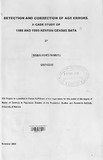| dc.description.abstract | This study focused on investigating the quality of age data in 1989 and 1999 Kenyan population censuses through detection and correction of age misreporting. The study had three objectives namely; to identify the nature and extent of age errors, make appropriate adjustment for age misreporting and compare the corrected age data with that of the Central Bureau of Statistic (CBS). The methods which were used were age ratio technique for the detection of age heaping, Feeney method for the correction of age heaping in multiples of five, Demeny-Shoiter method for the detection and correction of systematic errors and a combination of Feeney and Demeny-Shorter methods for the correction of age heaping as well as the systematic errors. On the other hand, linear interpolation was used for the estimation of mortality level. The results that were obtained were then compared with the CBS data so as to asses the appropriate method that can be used for the adjustment of Kenyan population census age data.
The data used were the 1989 and 1999 Kenyan population censuses, specifically age data in single years and five years age groups distribution by sex was used. The results obtained by age ratio technique indicated that there was age heaping in the two censuses .Age heaping was almost similar in 1989 and 1999 censuses in that there was preference of digit 0 and 5 with an exception of age 5 in 1999 population census, the degree of age heaping for both sexes was observed to increase with age but it was more pronounced in even age groups such as 10-14,20-24 as compared to odd age groups such as 5-9,15-19 and also greater in females as compared to males. In addition, age heaping decreased while age avoidance increased in 1999. Overall age misreporting was more pronounced in females as compared to males. The Results obtained by Feeney method indicated that there was systematic age misreporting and there was an increase of age under reporting in 1999 census as compared to 1989 census. From Demeny-Shorter method it was found that males had a high tendency to over report their ages while the females under reported theirs. Over reporting of age in males occurred at older ages but
in females this occurred among the teenagers and very old people 70+ In females under reporting was common in ages 30+while the same occurred among the teenagers in males.
A comparison of the results in this study and the data corrected by CBS suggest that when Demeny- Shorter and Feeney methods were applied individually and then jointly better results were obtained in the later as compared to the former. However discrepancies were found between the two data and this is attributed to; errors during the data entry which lead to wrong figures particularly for the total, the nature of the data that was used because in case of the CBS the data that was used had already been cleaned from irregularities but raw data was used in this study. However the methods used for the analysis contributed a lot for the discrepancies. The CBS used the Arriaga light smoothing technique which just smoothed data to reduce the effect of digit preferences and random errors. This was insufficient since the distortions that result from systematic over or under reporting was not put into consideration. When the projection of the two censuses data was carried out using the population data already adjusted by the combination of both Feeney and Demeny Shorter methods, the census coverage was found to be 96.44 and 99.7 in 1989 and 1999 censuses as compared to 94.0 and 97.3 obtained by CBS for the similar censuses respectively. In this study the adjustment of age data was carried for both random and systematic errors. Feeney and Demeny-Shorter methods were used and the main reason was that age misreporting in Kenyan census data is not only caused by random errors but also by systematic errors. | |

